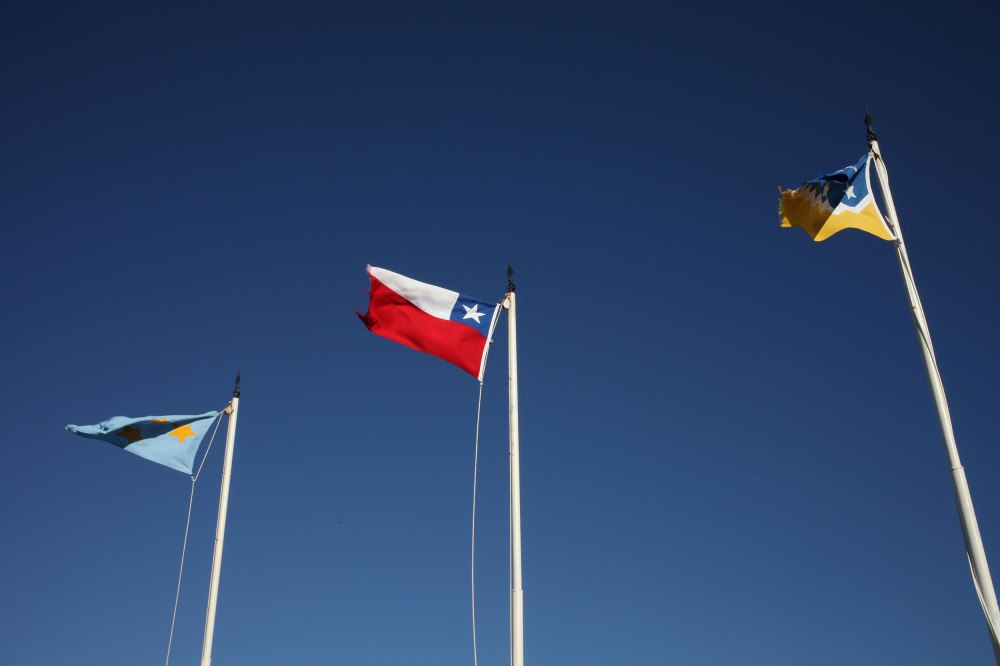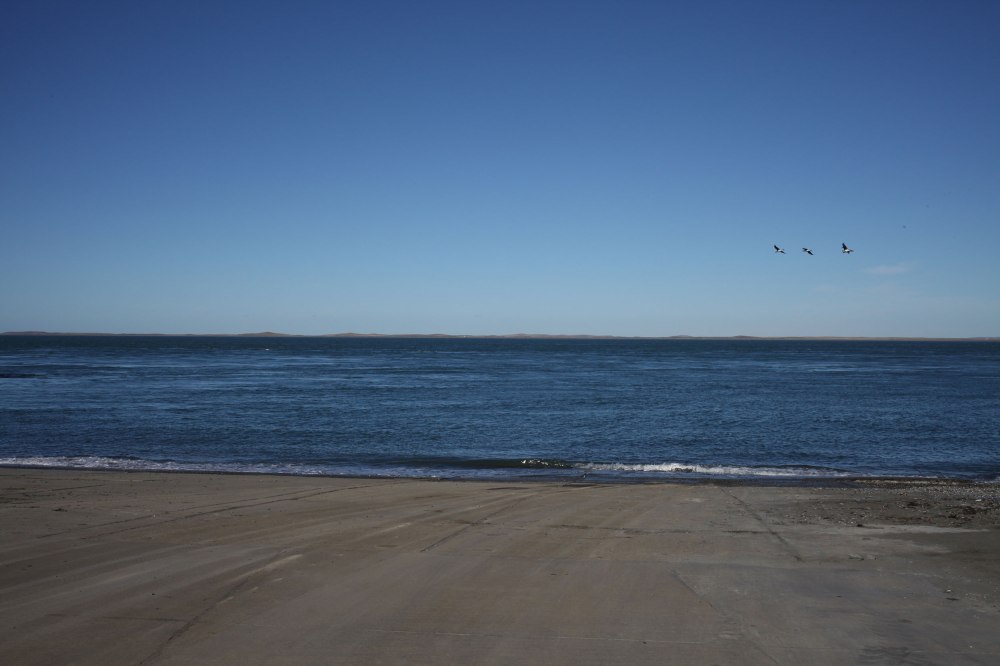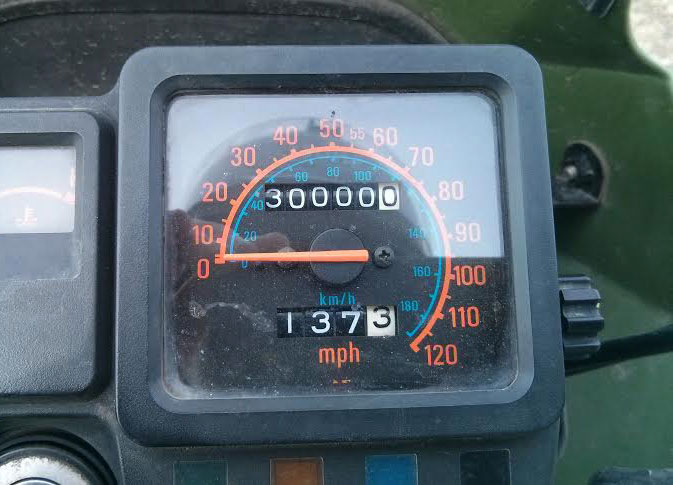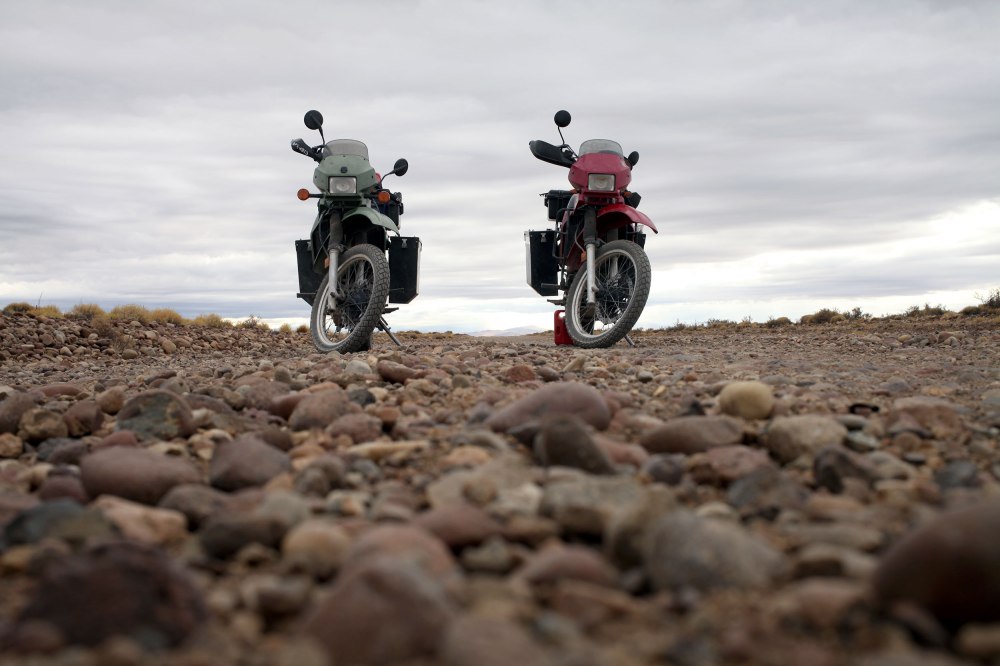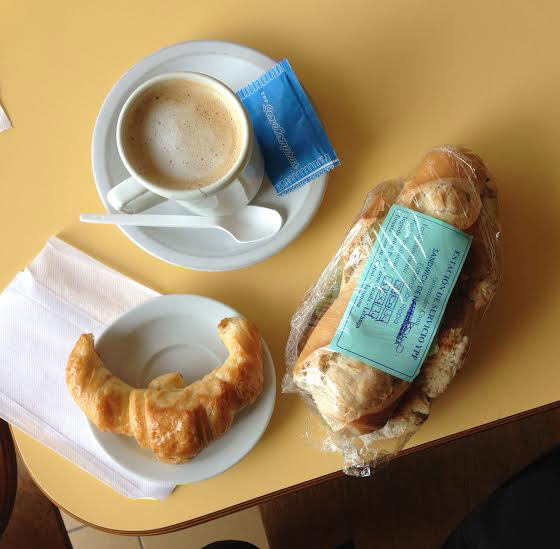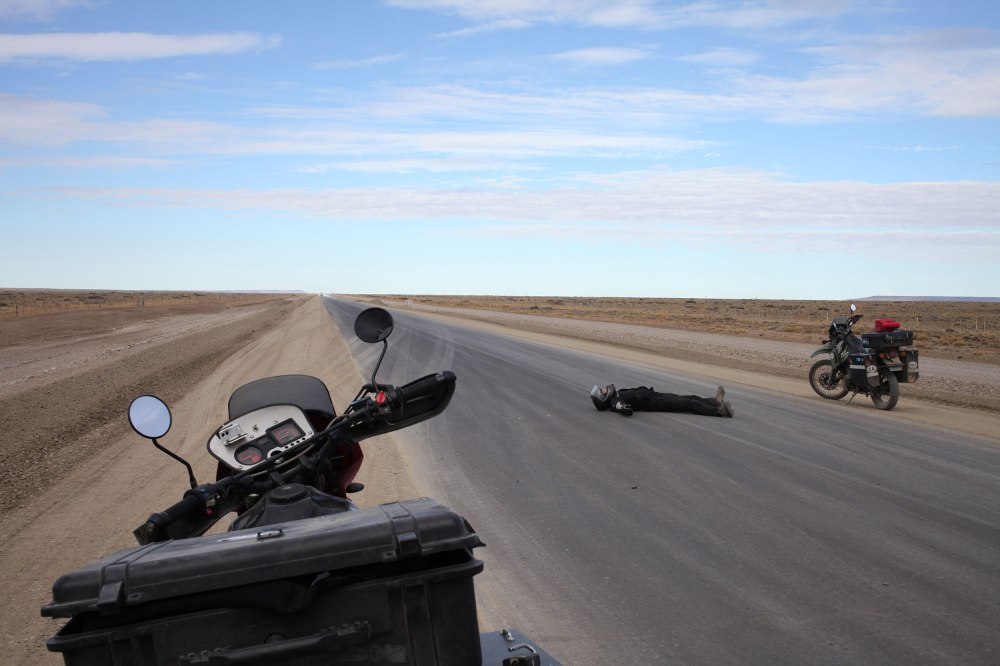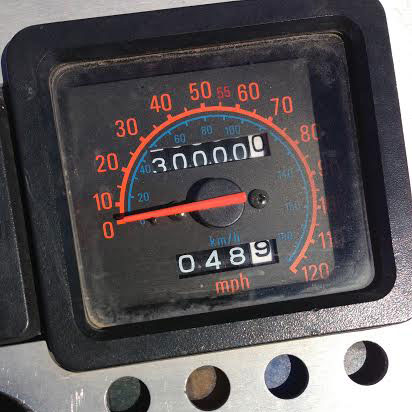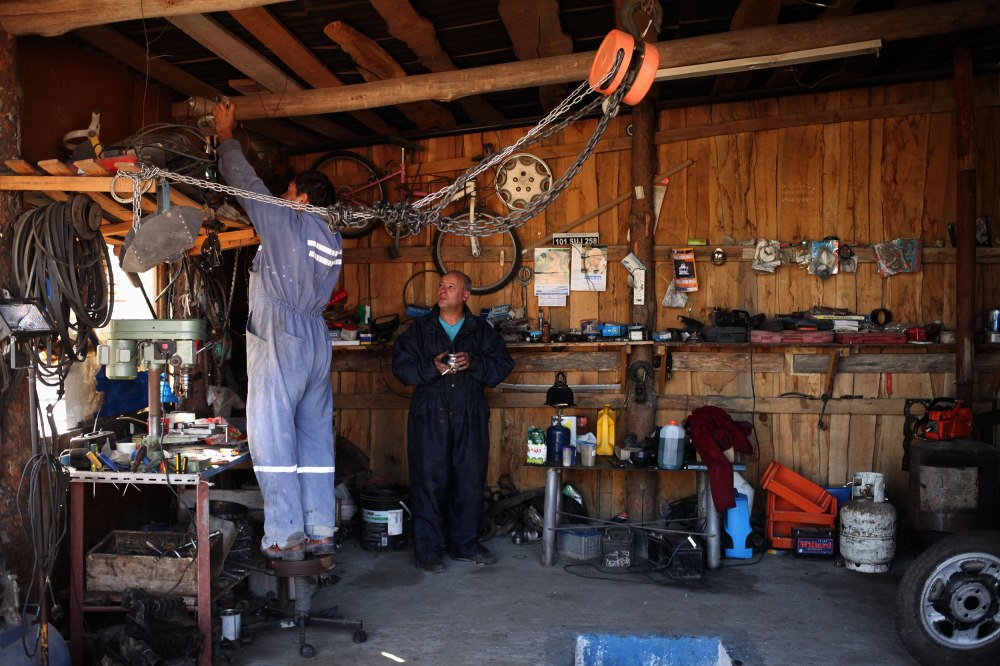Where the Autopista Ends
Two motorcycle bloggers in the San Francisco Bay Area.
Autopista Ended (Alex)
Posted on July 3, 2014

This is me in La Paz Mexico on one of the most frustrating days of the entire 7 1/2 month 15,500 mile journey. At this point I don’t know if I had just finished crying or was about to start. Photo: Nathaniel Chaney
I chose this picture for my “Autopista Ended” post because I am a huge fan of irony. I think the fact that my only frustration cry of the Autopista End trip happening after only a week on the road and in Mexico (where I used to live) is hugely ironic. Later in the trip, Nathaniel was often frustrated by how not-frustrated I would get when shit started going south.
If you followed us from the beginning you will probably remember that Nathaniel and I got stuck at the bottom of the Baja Peninsula for nearly a week. We didn’t import our bikes properly, we didn’t have the paperwork to take them to the mainland and the whole fiasco had us repeatedly going back to the La Paz immigration office, which has very short daily operating hours. It was the definition of mañana. I believe I originally described the experience as Kafkaesque.
Thankfully, our initial roadblocks on the trip were not indicative of how the rest of it went. We had intended to do a trip breakdown and describe how we shipped our bikes home once they returned to the USA but our bikes are still not back… For all I know they are floating in a shipping container somewhere off the coast of Colombia so the ‘how we got our bikes home’ post is going to have to wait.
We’ve been home for 11 weeks, Nathaniel has been back at his job for 6 and we’ve been in our new apartment for about 3. It’s almost disturbing how you can go on an epic adventure and then integrate back into your old life so seamlessly. I think that is the strangest part about being home.
As long as you have a good support system and some money in the bank the first world welcomes you back like a drug addiction. The comfortable lives we lead are designed to keep us anchored to a place, to things. Having everything the American Dream tells you that you should want and still being unhappy is the ultimate first world problem. I know a lot of college educated 20-somethings that are now quitting their jobs for the same reasons we did (more or less).
My personal goal now that I’ve returned from Autopista End Part I (yeah that’s right – we are already talking part II!) is to remind myself daily what I really want to be doing with my money, my time and my life. I don’t need to use shopping as a form of entertainment. I don’t need to eat out so much. I don’t need so much stuff.
The biggest thing this trip did for me was help me prioritize my life goals in a new way – they aren’t priorities I just repeat anymore, they are truths I feel inside of myself and for that I will always be thankful.
The Last Leg
Posted on April 14, 2014

Nathaniel pours two gallons of gas into his tank before we cross the border at San Sebastian back into Argentina. Photo: Alex Washburn
As we rode the final days into Ushuaia the road to the city at the end of the world never let up on us- not once.
We had adventures and missteps up until the very last day when all we wanted was to ARRIVE.
Pretty mountains and fuzzy foxes are much less impressive when you have been working towards one goal for half a year and you are so close, so close!
Rio Gallegos was a bigger town than we expected and you can see it coming from a long ways off. The ride that day was long and ugly with over 80 miles of unforgiving dirt that Nathaniel already talked about.
As we got closer it felt like Rio Gallegos kept getting farther and farther away. The only food we’d had all day was some potato chips and chocolate at a gas station so as the cold started creeping into our jackets we were two miserable human beings.
We kept coming up short on finding a hotel, but after I asked for help from a local motorcycle cop we quickly found a warm dry place with wifi and parking which is about as much as you can ask from a cheap hotel most days.
Nathaniel watched TV at the hotel while I went out to eat dinner, but we were both asleep pretty soon after we arrived. I can’t even begin to guess what time that was.
We had heard that our more experienced Canadian friends had done the ride from Rio Gallegos to Ushuaia in one day and it took them 11 hours. We were already half decided when we got up the next morning to leave Rio Gallegos that we would stop somewhere in the middle and not even attempt to compete with them. 11 hour days suck and we didn’t want to arrive to Ushuaia after dark.

These crash bars were not cheap. When I get home I will be writing the company several e-mails. Photo: Alex Washburn
Doing this wouldn’t usually be a big deal but the crash bars on my bike block the cap on the radiator so I have to take those off first. It was then that we realized my Happy Trails Nerf Bars (crash bars) had rusted and broke!
As we took apart the bike Nathaniel dropped the nut that holds the top of my crash bars onto the bike (never to be seen again) and we quickly realized that my bike had more than enough radiator fluid and would probably be fine to ride all the way back to California if necessary.
Nathaniel started putting my bike back together while I went off in search of a hardware store that would have extra nuts to put my crash bars back on. I was back in about 20 or 30 minutes, but by the time we gassed up and were actually ready to leave Rio Gallegos is was already 1pm and we had TWO border crossings ahead of us and would need to use a ferry to cross the Strait of Magellan!
The Island of Tierra Del Fuego is split in ownership by Chile and Argentina. After crossing back into Chile you soon arrive to the Strait of Magellan, cross on a ferry and then continue on to the border to cross back into Argentina after 80 miles of Chilean dirt/gravel road.
Just typing that makes me tired.
We arrived to the Straight of Magellan and joined a short line of cars waiting at the edge of the water. As we waited we started to get worried about how far we would have to ride on the the other side of the water to find a hotel. Getting caught out on a shit road in the middle of nowhere at night is one thing we had so far managed to avoid so I talked to some locals and other people waiting in line for the ferry and we were promised a town (very generously titled) named Cerro Sombrero on the other side of the water would definitely have hotels.
Cerro Sombrero ended up being an industrial collection of houses, three hotels and one mini-mercado stuck up on top of a little hill in the absolute middle of nowhere. The cheapest hotel was full of oil workers and had no open rooms, the second cheapest hotel had a room for us, but wouldn’t accept our Argentinian money! (we hadn’t planned on staying in Chile and didn’t bother changing money at the border)
This completely blew me away because this town is surrounded by Argentina! To go anywhere they need to drive through Argentina and Buenos Aries is way closer to this town than Santiago.
I promised the woman at the hotel we would come back (my bad) and told her we had to go to the ATM to get Chilean money. Of course the “bank” was closed and the mini-mercado people informed me that the town didn’t have an ATM machine at all.
¿En serio?
Sí!
As I talked to the people about the lack of ATMs and money changers in their town and kept translating things for Nathaniel one of the other customers in the mini-mercado chimed in and said there was one Hotel that WOULD take Argentinian money or Euros or US Dollars etc.
My plan of swapping bottles of liquor for a hotel room (the mercado took credit cards) went out the window as the other customer explained to us how to get there and although it was on the way into town I hadn’t realized it was a hotel.
This hotel was the only place we could sleep in between the Strait of Magellan and the Argentinean border – which was of course on the wrong side of 80 miles of dirt road.
I keep using ‘of course’ because the things stacking against us on this particular day were pretty hefty. We walked into the hotel and asked about a room, and you know what? It was OF COURSE the most expensive hotel of our entire trip at $162 USD.

Nathaniel does a fist pump as we cross into Tierra Del Fuego after ferrying across the Strait of Magellan. Photo: Alex Washburn
That makes my soul hurt. Most of the time we keep our hotels at or under $40 when we are really hurting for options. I will not compromise on food quality, but when it comes to budgeting I am all about $10 a night hostels when possible.
We paid for our room in Argentinian money which took a huge chunk of our cash and went to our room where we proceeded to dig bills out of forgotten pockets, journals and plastic bags to see if we had enough money for dinner and gas the next morning (Chilean gas is REALLY expensive).
We decided we had enough money to eat dinner and the Hotel’s menu of the day ended up being a lovely dinner of soup, roast chicken, potatoes and flan (our only meal that day besides a sandwich at the border crossing).
The electricity went on and off for most of the time we were in the snazzy hotel, though we weren’t too worried about it till the next morning when the town’s only gas station attendant told us he couldn’t give us gas because the pumps wouldn’t work without electricity.
¿En serio?
Sí!
He told us the restaurant on the crossroads just outside of town would be able to sell us some gas, which was echoed by a local construction worker but OF COURSE the restaurant owner had no idea why they would think he might have gas for sale. After talking to him we realized the next town (San Sebastian) was going to be our only hope unless we wanted to wait around for the electricity to come back on.
We decided to roll the dice and go for San Sebastian knowing that we’d probably have to use the little cans of gas we were carrying on the backs of our motorcycles before we reached the next station. Turning south out of the restaurant parking lot we had about 300 meters till the pavement disappeared and we were on dirt road all the way to San Sebastian- which we reached on fumes.
San Sebastian ended up being even smaller than Cerro Sombrero and didn’t have a gas station! We pulled over a few hundred yards short of the border crossing to curse our bad luck and the entire country of Chile when an entirely too stylishly dressed young man sauntered down the long dirt driveway we had parked in front- eyes glued to his iPhone.This guy (lets call him Watson) ended up being a doctor employed by the Chilean army as an emergency medic out in the sticks of Tierra Del Fuego. He is living at the army outpost while they attempt to clear land mines that were laid out during a conflict with Argentina several decades ago. His job is essentially to save peoples lives if a land mine is accidentally detonated.
Dr. Watson told us the army brought in a gas truck once a week, however he wasn’t sure if they could share any. He made a phone call to a superior before regretfully informing us they needed to keep the ambulances and trucks full although we should be able to get to the gas station on the Argentinian side of the border with the little bit of petrol we had in our emergency gas cans.
We gave him an Autopista End sticker and he sauntered away looking exactly like any well educated young person might in the United States. It was a very bizarre experience and his English was probably better than ours.
We poured our little cans of gas into our bikes and parked under the overhang of the Chilean border crossing, ate a few ham sandwiches and climbed back onto the bikes hoping the gas station was as close as Watson told us it was.
Less than a hundred yards past the Chilean border office we bumped back up onto silky smooth pavement and blasted through the next 10k to the Argentinian office and a glorious little gas station with a super friendly attendant. Hallelujah!
After filling our tanks we were on a total high. Just a few hours from Ushuaia I got this insane adrenaline rush and I just felt like I was floating in my seat. We filled up again in Rio Grande to make the last push to Ushuaia and we were just so happy and excited.
I think that I had the equivalent of a caffeine crash with my adrenaline because about an hour outside of Ushuaia I just had to tuck in behind a slow moving Fiat and zone out. The mountains were freaking gorgeous, the lakes were perfect and the asphalt was a dream, but I was just too cold, too sore, too tired and too road worn to care very much.
I dully acknowledged that is was some of the most magnificent scenery we had ridden through in WEEKS, however I just couldn’t get excited enough to ignore the cold. I practiced answering job interview questions in my head and stayed behind that little fiat all the way into USHUAIA.
We rounded one last turn and so unexpectedly the giant USHUAIA welcoming posts appeared in front of us. We took pictures with other Ushuaia signs later, but at that moment we just needed a hotel.
Like tired marathoners we passed a group of motorcyclists collected at the signs, rolled through the posts and slowly pulled over to congratulate ourselves and indulge in some celebratory high-fives!
After 6 months, 16 countries and 15,500 miles we had reached our epic destination- THE END OF THE WORLD.
The Great Chase
Posted on April 10, 2014
After our adventures with Alex’s radiator, we were both eager to finally get on the road and ride every day till we made it to Ushuaia. We got up the next day and headed off on Ruta-40, after having breakfast at the gas station we filled up at (Note: Argentina has some pretty awesome gas stations with meals, that sometimes, are better than you would find in a restaurant). The sky was looking dark, and we wanted to get on the road to hopefully avoid any more rain, as the temperature was likely to continue to drop as we moved south, and riding in wet gear does nothing but slow you down.
About 50 miles down the road it curved and within the next five minutes we were facing bright blue skies, it was one of the few times on the trip we were able to out run the rain (the next time being the following day).Ruta-40 is famous in Argentina, and in all of South America, with many tourists viewing it as akin to Route-66 in the US. It runs all the way from La Quiaca, in Jujuy Province, in the North to Punta Loyola, near Rio Gallegos, in the south a total of 3,107 miles.
While the Argentinean government made a resolution in 2006 to pave the entire length of Ruta-40, Alex and I experienced first hand that this is still a work in progress. Talking to locals, mechanics, hostel owners, I had even bought a map that listed what routes were paved and not paved in Southern Argentina, to try and give us a shot at not doing anymore 120-mile dirt/gravel roads, to help speed us along.
All of this planning was for not when we reached Alto Río Senguer, filled up with gas and had a cup of coffee, all with the plan to ride to Perito Moreno along the 40, since we had already done 120 miles that day with no issues. Leaving the gas station we followed signs toward Rio Mayo (along the way to Perito Moreno) and stopped just shy of the edge of town as the road became, what the locals call, “ripple” or gravel.
We double checked the map to make sure we were going the right direction (we were) and agreed that this must just be a section of gravel that lead back to the great asphalt of Ruta-40 we had been riding on all day (pipe dream). About five miles into the ripple road, a truck came cruising by and we flagged him down so Alex could ask if we were in fact on the 40 and how long the ripple continued. His response was that yes we were on the 40 and that it was ripple the whole way to Rio Mayo, about 60 miles.

This was the ‘scenery’ we faced between Gobernador Gregones and Tres Lagos. It wears on the mind, body and soul. Photo: Alex Washburn
There was no way we were going to make it to Perito Moreno, and I had doubts on how long it would take us to reach Rio Mayo as it was already two in the afternoon. I also wished I could go back and yell at the gas station owner, who we asked about Perito Moreno and he never mentioned once that the road there was all ripple. We continued down the road at a snails pace, only reaching second gear once, and barely cresting 15 miles an hour on the good stretches.
Concerned about the integrity of my gas tank (it had been welded in two places) Alex took the lead and soon disappeared around the corner. I continued at my ten miles an hour pace, going to the happy place in my mind and trying to ignore the otherwise complete lack of scenery. Cruising around the corner I soon saw Alex’s motorcycle, on its side, Alex standing next to it. The gravel had gotten big and deep, and she lost control and had to let it fall. Nothing the KLR can’t handle, and we both lifted it back onto two wheels and noticed that the radiator was leaking again.
Not having the time, we had only done 30 miles at this point, or the tools to fix it we decided all we could do is continue on and get desalinated water and coolant further on down the road. Another 30 miles of bland scenery, gravel, and ten miles an hour landed us on the door step of Rio Mayo, just as the last rays of sun light faded from the sky.
The next morning, we asked the hotel owner and the gas station attendant about the road to Perito Moreno, with the hotel owner being less than helpful, but the gas station attendant confirming it was about ten miles of ripple, and then asphalt all the way to Perito Moreno.
The ripple for that ten miles was the worst of the trip, by far. Large stones that move when you hit them and then the monster truck tire marks of road that combine for slow painful driving. (I try to not exaggerate, and am sure some riders would call us wussies for complaining, but when you’re close to the end of a 15,500 mile ride you really don’t want anything to happen to your bike, and riding on these roads is hard on both rider and bike). We finally reached where the asphalt began, and enjoyed the freedom of being able to do 70mph again, all the way to Perito Moreno.
In Perito Moreno we filled up with gas and asked the attendants about the conditions of the road to Tres Lagos (our intended stop for the night, and original stopping point after Perito Moreno, trying to get back on track). He confirmed it was all paved for about 500km, which would get us to Tres Lagos at least.
Riding from gas station to gas station, we made our way toward Tres Lagos, on amazing asphalt through dry plains. 100 miles, 200 miles, we pulled into Gobernador Gregones as the sun was setting, though with the goal in mind that we were going to make the push to Tres Lagos to stop from falling behind. I suggested to Alex that we should ask some locals about the road, just to make sure we didn’t get stuck on another ripple road, at night time.
After talking with a truck driver (they always know the best roads, and have really great concepts of distance) we learned that the road would be about 40 miles of asphalt and than would turn to ripple for another 80 miles till Tres Lagos. We were staying in Gobernador Gregones for the night, but good thing we asked.
It wouldn’t be till the next morning that we would find out that we somehow got off the 40, to get to Gobernador Gregones, but the 40 turned to ripple anyway, and wouldn’t have saved us anytime. It was off to another long day of gravel.
The truck driver was right on and after 40 miles, the road suddenly ended into a dirt road. It bears mentioning that the first 40 miles of this road was some of the best ripple road of the whole trip. Compacted dirt with little to no rocks that allowed us, at some points, to make it up to 40mph. At some point this ended, and was replaced with the larger rock ripple, that only allows 10mph and fatigues body and mind.
The detour to Gobernador Gregones ended up being a blessing in disguise as it not only prevented us from trying to get to Tres Lagos in one day, but also from having to stay in Tres Lagos, which didn’t have any real roads leading to it and in general looked less than welcoming (though I don’t actually know as we never made it into that town, but simply skirted it).
It took us four hours to go 80 miles and make it to Tres Lagos, however once we made it there we were hell bent on making it the rest of the way to Rio Gallegous, our original plan for those three days of riding. It would be another 200 plus miles of riding, ending the day at 360 miles, to get us into Rio Gallegos after the sun set.
99 Problemas
Posted on April 7, 2014

I made a pillow out of my motorcycle gloves and a Marc Jacobs clutch (because I’m fabulous) to lay down as we waited for the JB Weld to harden during our first attempt to patch the radiator. Photo: Nathaniel Chaney
As my bike odometer ticked off the final tenths of a mile to 30,000 I started to slow my bike, shifting down through the gears I came to a slow stop and pulled out my phone to take photos of the odometer as Nathaniel parked his bike and jogged up to me.
I had missed taking a photo of the 20,000 mile reading in Guatemala (it had been raining) so the 30,000 mile mark felt extra special for both of us. Nathaniel started doing a happy dance, however my laughter was cut short as he pointed at the ground “Holy crap babe- your bike is leaking!”
I looked down and an acid green liquid was all over my boots and engine, it had even puddled on the inside of my skid plate. I parked the bike and under closer inspection we realized the thin metal grating that protects my radiator which has been broken for sometime had rubbed a hole in the wall of my radiator!I know that sounds bizarre, but since I ‘temporarily purchased’ the bike from Chuck Squatrigilia (who I also refer to as my motorcycle mentor) a year ago I’ve put somewhere around 20,000 miles on the bike. In 20,000 miles anything is possible.
It also kind of blows my mind I’ve put 20,000 miles on that bike in a year. My first year riding! Anyways…
Together we removed the screen and brought out the JB Weld. JB Weld is some amazing stuff, though it takes at least an hour to harden to the point where you can test whatever you are attempting to fix with it.
I tore off a piece and mashed it into a ball, rolling it around in my hands over and over till it was a uniform color I began trying to mush it over the hole that had been leaking the bright green fluid.
I say try because it would not stick although we had wiped the area dry. I tossed the useless already hardening putty into the bushes, tore off another piece and started the process again.
The second time it seemed to stick well so all we had to do was wait an hour before turning on the engine to see if the JB weld would do its job.
I took a few photos, Nathaniel took some photos, I skipped rocks across the road, we waited. I made a pillow out of my winter riding gloves and a Marc Jacobs clutch so I could lay down on the side of the road. I am sure any passing motorists thought I was crazy.

We were only 10 kilometers from the nearest town but it felt like we were in the middle of nowhere. Photo: Alex Washburn
After an hour we decided to try the bike and see if the JB Weld was going to hold my radiator fluid. Nathaniel started it up as I knelt on the ground to inspect the patch and it looked fine! We were so excited! 10 seconds, 20, 30, Nathaniel suggested we rev the engine to an rpm it would have to run at when we got back on the road and once he got it up to 3500RPM the green liquid start to ooze out of invisible cracks, which quickly turned into a steady drip puddling in my skid plate.
We shut the bike off and I reached for more JB Weld. We had enough daylight left to try this one more time before we were going to have to try something drastic like towing my bike behind Nathaniel’s without proper rope.
I began mashing up the grey putty as Nathaniel wiped the bike dry again so I could apply it. Carefully tapping and rubbing the JB weld onto its self I held my breath hoping it would stick and it did.
We had another hour to wait.
We waited.
And, it didn’t work.
We were frustrated at this point mostly because it was going to be dark within an hour and still being up in the mountains it was getting cold. I waved a car down and asked if they had any rope. They didn’t have anything we could use to tow my bike, however they said the next town was only 16 kilometers away (ten miles), which was helpful to know.
I figured the only option was for Nathaniel to tow me with his bike so I connected my leather belt from Gap to the metal cable we use to lock up the bikes, which I in turn connected to a random length of orange stretchy cable (I don’t know where it even came from) using our padlocks. I thought it would hold, but Nathaniel had his doubts. The part I was most worried about was that it was only long enough to give us about two feet of space between his back tire and my front tire which I don’t need an expert to tell me is stupid and not at all safe.
We were both nervous because although we have ridden so far in the last few months we are still newbies when it comes to motorcycles. We still need help sometimes deciding if something can be fixed with duct tape or if we need a real mechanic. And of course, neither of us has ever towed a bike or been towed while riding one.
The way KLR plastics are shaped made it really hard to find something to wrap the cable around in the first place and our bikes have a much higher center of gravity than say a Harley-Davidson, which makes tipping over at low speeds really easy to do.
With my bike in neutral I was completely tense as Nathaniel carefully let his clutch out and got his bike rolling. The strange assortment of cables and leather held and I started to roll forward, but my front forks were jerked to the left and then the right and back again. I yelled at Nathaniel to stop, we took a breather and we tried again.

Alejandro is the only mechanic in Tecka Argentina, but from what we could tell he is a pretty handy one. Photo: Alex Washburn
I had no control over where my bike was going and Nathaniel said he was getting jerked around as well.
I think we got about 30 feet before we gave up.
It was at this point we decided that I just had to drive the bike to the next town. Neither of us wanted to leave the other waiting on the side of the road and Nathaniel doesn’t speak spanish so sending him ahead didn’t make much sense anyways.
It was cold enough out, and the JB Weld had slowed the leak down to a slow drip, where I thought my bike would be okay.
We were to the next town in a few minutes (exactly ten miles, which is surprising considering many times we have been told one estimate and had it be completely wrong),however it was much smaller than we thought. It was tiny. Like- so small if you were in a car and your passenger dropped something on the floorboard they might miss the town while they were bent over looking for it.
Just past the town’s only gas station Nathaniel pulled onto what looked like a paved driveway and braked very quickly. I braked hard to avoid hitting him and unfortunately for me the part I had to brake on was covered in gravel (of course).
My back end started to fishtail and I almost kept it upright. As my bike came to a stop it leaned so far I had to put my feet down, but it didn’t help. The bike was going over although there were a few seconds where I though I could hold it till Nathaniel got off his bike.
The bike was leaning at a 45 degree angle and both my feet were solidly on the ground, though I was straining to hold it in that position. Nathaniel saw what was happening and tried to get off his bike to help, however I realized (thinking back to a story about my Dad) that it wasn’t worth hurting myself to keep the bike from falling another two feet.
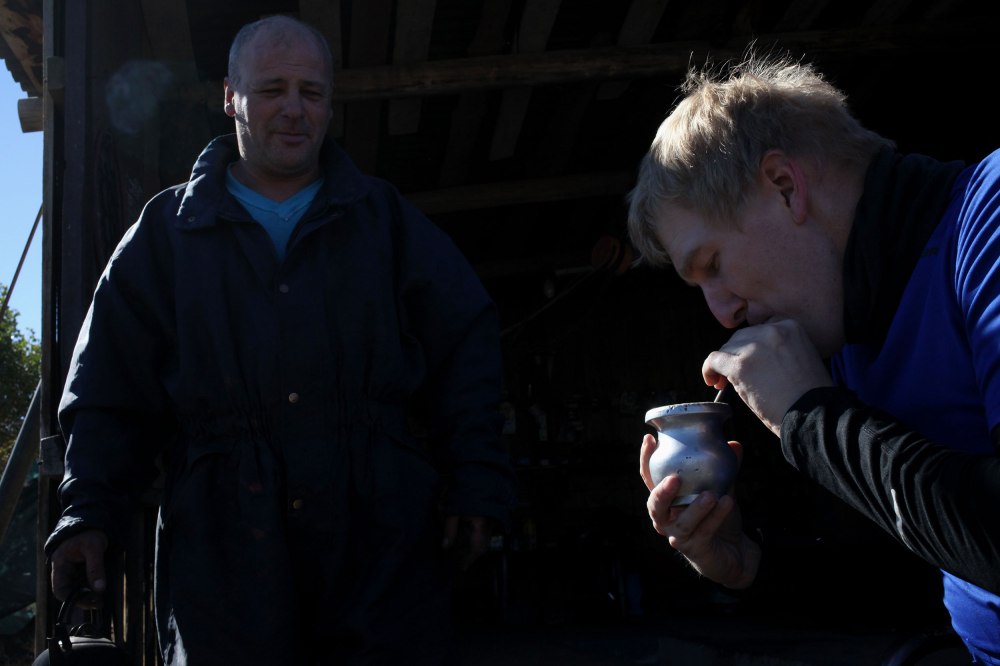
We spent pretty much an entire day at Alejandro’s shop and he taught us about mate! Photo: Alex Washburn
So, I let the bike go as I hopped to the right onto the ground with it to keep myself from getting pinned under it. Nathaniel helped me pick the bike back up and the KLR was of course fine, but I broke my THIRD mirror of the trip. (I assure you I teased him about this for the rest of the night.)
We were lucky that Tecka had a hotel because the next town wasn’t for 50 miles. The hotel ended up being a part of the gas station so after we locked the bikes up we bought some cold cuts, bread and chips to have a picnic in our room. It was sadly enough one of the more satisfying meals we had enjoyed for several days.
The next morning finding the town’s mechanic (Alejandro) was pretty simple seeing as it was the building with all the rusted cars laying in front of it. Alejandro appeared from across the street after we had only been waiting at the shop for a few minutes (it was early) and I tried to explain what was going on with my bike.
He told us to bring the bike over and he’d take a look at it.
Once he saw the problem he assured us he could fix it. Nathaniel went to get us coffee and pastries at the gas station while Alejandro and I went to work taking the bike apart. If I didn’t have the panniers and top box on the bike it would still be a little bit of a chore to remove the radiator, however all told you have to take off something like 19 bolts before you can even think about touching it.
Once we actually had the radiator out it didn’t actually take Alejandro that long to clean the aluminum with some acid and solder it back up. He also put some kind of hardening epoxy mixed with steel wool over the solder and explained that the epoxy can flex more with extreme temperature changes and will help the solder hold.
After we put everything back together it came time to pay and we did not have enough cash on hand. Nathaniel rode to the only ATM in town and it was empty! (of course)
I asked Alejandro where the next atm was and he said I could find one in the next town 50 miles away! So, off I road at about 70 miles an hour down the highway, checking to make sure the patch held about five miles down the road. Finding the ATM was easy and I powered down a milanesa sandwhich at that town’s only gas station before turning around and riding another 50 miles BACK to Tecka.
Nathaniel says that while I was gone Alejandro decided to make us dinner and went to the store to buy a chicken for us. This was how we found ourselves being fed dinner once again by a Argentinian mechanic.
After dinner we pushed on south once again, making it back to the town with the ATM and the gas station!
